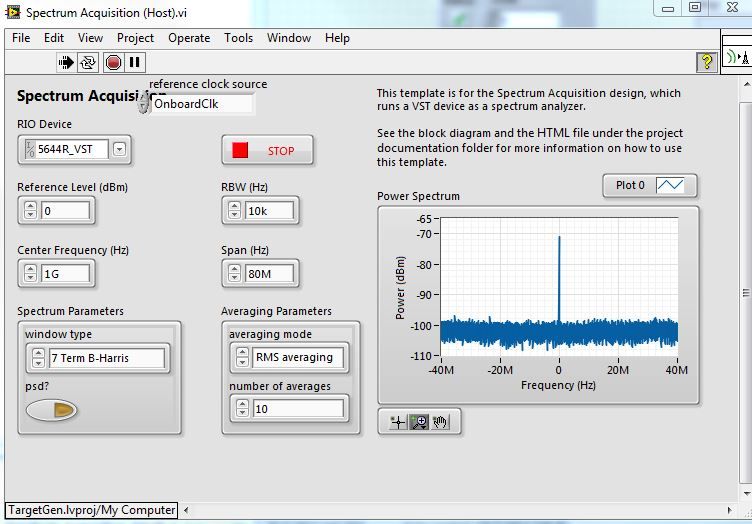- Subscribe to RSS Feed
- Mark Topic as New
- Mark Topic as Read
- Float this Topic for Current User
- Bookmark
- Subscribe
- Mute
- Printer Friendly Page
VST Spectrum Acquisition(Host).vi
08-05-2013 12:34 AM
- Mark as New
- Bookmark
- Subscribe
- Mute
- Subscribe to RSS Feed
- Permalink
- Report to a Moderator
Why there is a -72dBm signal even without an RF source connected to the RF IN port of the VST (PXIe-5644R) when using the example: Spectrum Acquisition(Host).vi?
Using the RFSA soft front panel, no similar signal is detected, is this a bug on the provided exanple?
Same case if using the example for RFSA: RFSA Getting Started Spectrum.vi, no signal is also detected.
08-09-2013 03:06 PM - edited 08-09-2013 03:06 PM
- Mark as New
- Bookmark
- Subscribe
- Mute
- Subscribe to RSS Feed
- Permalink
- Report to a Moderator
Good afternoon!
What you're seeing is not actually a bug, but rather the result of different acquisition methods implemented in these two examples. The RFSA Soft Front Panel (SFP) uses spectral stitching to combine several chunks of the spectrum into a single display and it knows to ignore the small range in which the Local Oscillator can be seen. The Spectrum Acquisition example uses a single chunk and so cannot remove the LO from the plot. An example to provide a more direct comparison to the Spectrum Acquisition example is the RFSA In-Band Retuning example. You will see the LO in that plot as well. I hope this helps!
Thanks,
James Duvall
National Instruments
08-09-2013 03:11 PM
- Mark as New
- Bookmark
- Subscribe
- Mute
- Subscribe to RSS Feed
- Permalink
- Report to a Moderator
Additionally, table 7 in the PXIe-5644R Specifications show how much residual LO Power you can expect to see:
http://digital.ni.com/manuals.nsf/websearch/24B44D4B2E85C81B86257AE7008222E6
Thanks,
James Duvall
National Instruments
12-18-2014 10:04 AM
- Mark as New
- Bookmark
- Subscribe
- Mute
- Subscribe to RSS Feed
- Permalink
- Report to a Moderator
Does this mean that I can expect issues (or additional filtering) when analyzing a 1 GHz signal with a PXIe-5646R?
12-18-2014 11:24 AM
- Mark as New
- Bookmark
- Subscribe
- Mute
- Subscribe to RSS Feed
- Permalink
- Report to a Moderator
Emonk,
It is important to know about the LO leakage at -70dBm so that you can avoid it if necessary.
For example, if you are trying to measure a very low 1GHz tone, (at/near the LO level, <= -70dBm) then you would want to either:
a) use a LO offset from 1GHz center frequency, which would move the LO leakage out of the way. This is why the Absolute Accuracy measurement in table 4 (http://www.ni.com/pdf/manuals/376125a.pdf) are measured using a 3.75 MHz offset from the center frequency (see table footnote).
b) use the example James mentions above, which is essentially the same thing.
You could probably come up with scenarios where it could cause issues, but it is very narrow and well defined, and therefore easy to avoid.
For more information on this topic you may find this white paper useful
http://www.ni.com/white-paper/14028/en/
Kitt


